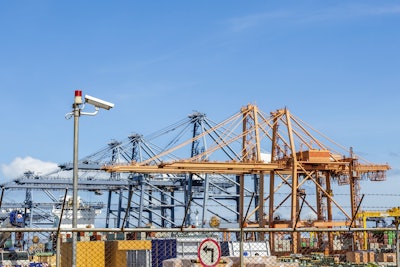
As a sector, food and beverages are particularly vulnerable to theft. Indeed, the sector ranks as the number one target for thieves according to companies that monitor such activity. For consumers that unknowingly buy goods from retailers who procure food or beverage products from the gray market, the risks are compounded when safe handling, including temperature monitoring, are neglected.
Following are three perspectives from industry executives that shed light on current trends and developments relating to cargo theft and how best to combat the risks — Lara L. Sowinski
Taming the appetite for food theft in the supply chain
by Richard Kolbusz
According to FreightWatch International’s U.S. Cargo Theft Intelligence Report Q2-2015, food and drink has been the most frequently stolen type of freight since 2008. Given that food and drink products are difficult to recover because of how quickly they can go to market, they are “hot commodities.” Despite their propensity for theft, however, they can be safely transported, warehoused or protected from contaminants if proper safety protocols are in place and red flags identified in the supply chain.
Not only does food and beverage cargo theft affect the bottom line for the growers and manufacturers of these products, but also the consequences can be deadly for the general public. Imagine that a truck carrying cases of baby formula is intercepted and a number of boxes are stolen, tampered with and repackaged with a different substance. The potential for disaster for a number of babies and their families can be unimaginable if this formula is somehow placed back in the legitimate supply chain.
For freight forwarders, security should be paramount at all times, en route to long distances, during local shipments, at the warehouse and in containers.
Securely going the distance
For companies importing or exporting any type of prepackaged food item or perishable, it is necessary to partner with a logistics company that has technology in place, such as Global Positioning System (GPS) and electronic security seals, monitoring the movement of the goods at point of origin, en route and at final destination. Freight forwarders should be able to monitor the movement of all of its trucks, in addition to having checkpoints during long distance trips to ensure no tampering of the cargo has taken place. Pre-alerts before arrival at final destination are also a best practice that helps ensure safe arrival. High-tech monitoring systems should also be in place for both cargo traveling in ocean containers or via air freight.
Considerations for perishables
For perishable food items, temperature control is necessary and is one of the most basic services a logistics provider should offer. A full range of services, including the proper conditions and compliance of perishables across the supply chain, prioritized space allocation, handling at origin and destination, sanitary inspections and quality checks, should be part of any reputable logistics company’s service offerings. Additionally, control of temperature, quantity and any type of damages throughout the transport should be alerted to the customer. Some logistics companies may offer temperature control monitoring while the merchandise is in their possession, but often some companies use third parties to finish the final leg of the cargo’s journey and may not have the same temperature control processes or systems in place to alert if cargo has been delayed, and the cold chain has been compromised. It is necessary to work with a partner that has full visibility of its third parties or the vendors it works with to ensure they are also complying with critical established processes.
Warehousing: where risks may lie
A warehouse can be a place of several security risks, particularly when storing consumer items, such as food. Given its high propensity for theft, sometimes these products are at risk of “systematic robbery,” wherein warehouse employees steal the items from the cargo housed in the warehouse in small quantities. To avoid this type of theft, it is of the utmost importance that the designated logistics company has a merchandise auditor in place to validate the quantity of the merchandise upon receiving it and when it leaves the warehouse. All logistics companies should have rigorous detailed inspections of all cargo received. It is also important to have protocols in place for when any of the warehoused products expire or are damaged, so that the food company is alerted and provides authorization for its proper disposal. There are times when a warehouse disposes of food, and thieves ransack garbage dispensers located outside of the facilities to salvage the products and sell them on the black market or introduce them into stores. Other risk factors can include theft of products for the use of their packaging to store false or impostor products. The careful and rigorous hiring of warehouse personnel and supervisory processes are necessary to maintain the integrity of the brands being shipped.
Contamination
Food contamination is when a harmful chemical or microorganism, such as a bacteria or toxic substance, become present in the food and can go on to cause consumer illness. The contamination can occur in a number of ways: at the food processing plant, during shipment or at the warehouse. It is extremely important logistics companies understand the specific storage requirements of the food products, as well as which can be stored together or separately. In the case of asparagus that is warehoused in a cold room, it is important for a logistics company to know it cannot house this vegetable in close vicinity to flowers. Asparagus is one of the most sensitive vegetables to ethylene gas which is generated naturally by all vegetation, in particular that which is cut or decaying. If not properly stored, cross contamination can occur and ultimately premature decay of the asparagus.
Other contaminants can include pests, including rats or ants that can reside in a warehouse, container or truck environment. Other pests such as weevils, which are found in fields or gardens, can be transported in a shipment with grains or seeds, and quickly spread to other cargo if not properly inspected or if the facility does not conduct proper sterilization. Also, transport vehicles, such as trucks and containers need to be thoroughly inspected before loading of all cargo.
Distribution of food in high risk areas
The journey for food can at times be a dangerous one if the cargo has to move through an area of high crime or political instability. In some parts of the world, cargo is often accompanied 100 percent of the time with armed guards or in convoys to ensure safety in numbers. Through in-depth field studies, freight forwarders can obtain information on high-risk areas of high extortion and crime, as well as routes where upcoming protests are to take place. The job of the freight forwarder is to establish emergency protocols and ensure their staff and drivers are fully aware of the protocols and informed of any upcoming route deviations and changes.
The risks of food theft and contamination can be great in the supply chain, making it necessary for companies to thoroughly inquire about their potential logistics provider’s safety protocols and warehousing options. End-to-end visibility, safety guidelines, certifications and expertise are key to choosing the right logistics company that can get your food and perishables safely to consumers’ table.
Richard Kolbusz is the head of security and operational resilience for DHL Global Forwarding, Americas region.
As cargo theft rises, a proactive food defense strategy is more important than ever
by Don Hsieh
In 2014, FreightWatch International recorded 794 cargo thefts throughout the U.S., with an average value per theft of $232,924, a 36 percent increase in value over 2013. For the fifth year in a row, food and beverages was the most common type of product stolen, accounting for 19 percent of the total. Food and beverages are easy targets for criminals because they lack serialization used for identification purposes on products like electronics. Without any form of identification but with well recognized brands, they’re easier to resell through legitimate channels, making them much more profitable. Thieves make as much as 70 cents per dollar when selling stolen food or beverages as compared with just 30 cents for electronics. Since these are the most lucrative products for thieves, food and beverage companies should ensure they have a proactive and comprehensive food defense strategy in place to monitor and protect their products beyond the four walls of their facilities.
Attacks can happen anywhere, instigated by anyone in the chain—including employees, so companies must control access and maintain visibility throughout the supply chain. The highest value thefts are within inventory-rich facilities and are the most prone to inside jobs. Once a shipment leaves the facility there are many risks and vulnerabilities along the journey to its destination. Some thieves pose as legitimate parties hired to pick up cargo at a dock so identification of who makes pickups and deliveries must be authenticated. Others exploit idling unattended trucks and simply hijack the vehicle so truck movement must be monitored and controlled. If theft occurs and a product is compromised due to improper refrigeration or sanitization, for example, consumers may suffer health repercussions and your organization will face costs associated with recalls and litigation that can impact future revenue and market value. The best way to avoid these safety, financial and brand reputation threats is to stop cargo theft before it happens by building a proactive food defense program—and that starts with the Four A’s of actionable food defense: assess, access, alert and audit.
First, assess the risks throughout the whole supply chain. Start by conducting a vulnerability assessment of critical control points. Think about points where someone could attempt adulterating a product—both inside and outside your walls.
Second, organizations should consider who has access to critical control points. Utilize physical identity and access management solutions to restrict access to particularly vulnerable areas within a facility to only authorized personnel. Securing of cargo in transportation should be a critical focus of a food defense program, as product could be stolen, diluted, or otherwise adulterated, and then sold, again causing risk.
Next, continuously monitor critical control points to alert appropriate individuals of any instance of potential food adulteration. There are multiple ways for cargo thieves to access products from the warehouse to deceptive pickups through in-transit cargo theft. By implementing a strict, multi-layered security process and advanced technologies such as integrated video, access control and radio-frequency identification (RFID) tags, many of these thefts are preventable.
Lastly, organizations should audit operational and regulatory compliance to ensure and maintain best food defense practices and provide documentation of compliance to regulators. Several of the FDA’s Food Safety Modernization Act (FSMA) rules have started to be enforced and businesses will be required to document that they are following these types of practices. FSMA promotes the safety of the U.S. food supply by focusing on prevention, rather than reactive response. However, prevention is only as effective as the actual compliance processes put in place. Regular and random auditing using remote video technology can go a long way in confirming that appropriate preventative measures are in place and working.
The most important purpose of a proactive food defense strategy is to help increase consumer safety, but protecting the brand and company profitability should also be considered. Implementing preventative controls built on actionable intelligence to protect the food supply chain is much more effective than reacting to an event after it happens. The Four A’s of a proactive food defense program deliver comprehensive monitoring and control over the integrity of a company’s complete supply chain, inside and outside the walls of a facility.
Don Hsieh is director of commercial industrial marketing for Tyco Integrated Security.
Cybersecurity Risk for Fleets
By Wes Mays
Everyone seems to be most concerned about terrorism...and while that is obviously a concern, I think the biggest and most widespread threat is going to be true cyber security—the silent type that is difficult to detect.
The theft of corporate information such as routing plans, manifests, logistic information, customer lists, costing information, fuel costs, and other competitive information that can be used to “win” business using that stolen information for competitive advantage. The victims probably won’t even realize it.
There are multiple layers of network, telematics and vehicle security in place. For obvious reasons we are not going to disclose what that is and how it works. Fortunately, for fleets and commercial vehicles, the biggest safeguard is that the driver is still in control of the truck. It is also worth pointing out that most telematics systems allow for remote programming of the telematics system, so any security breaches can be remedied over the air, quickly preventing further exploits of the same attack.
Clearly, the opportunity to hack into a truck depends on what type of equipment is installed. For example, the more control by wire systems there are, the more likely it is that a system can be compromised, thus more care must be taken to ensure safety and security. Consider the old emergency brake design that uses a physical cable. This is purely a mechanical system. There are no electronic components, and so there is no electronic way to engage the brake. Does that alone make the system secure? Not necessarily; you could conceivably crawl under the vehicle, find the cable and cut it to disable the function, or add tension to it to force engagement of the brake.
So even non-electronic systems are hackable, albeit by different methods. Modern electronic vehicle technology just makes the factors more complex. The sub systems themselves on a vehicle may take action based on inputs from another subsystem on the vehicle. For example, a collision avoidance system may have the need to engage the braking system. Once the braking system is designed to take electronic input from another subsystem on the vehicle, that exposes an attack point. Now consider the complexities of a vehicle network and telematics devices that essentially connect the vehicle to the Internet and you start to see the potential safety and security threats to a vehicle.
Ultimately, security and safety have to be designed into the vehicle and the telematics systems need to be included up front in cooperation between OEMs, tier 1 suppliers, telematics providers, and the owners/drivers that add other aftermarket equipment. The responsibility for fleet cyber security is going to be everyone’s.
Wes Mays is director of OEM product innovation for Omnitracs.
For More Information:
DHL Global Forwarding, dhl-usa.com
Freight Watch International, freightwatchinternational.com
Omnitracs, omnitracs.com
Tyco Integrated Security, tycois.com
















